Siam’s former capital city still holds plenty of glimpses of its former spiritual and political glory. But to get those glimpses, it’s necessary to navigate the trappings of modern, urban Thailand.
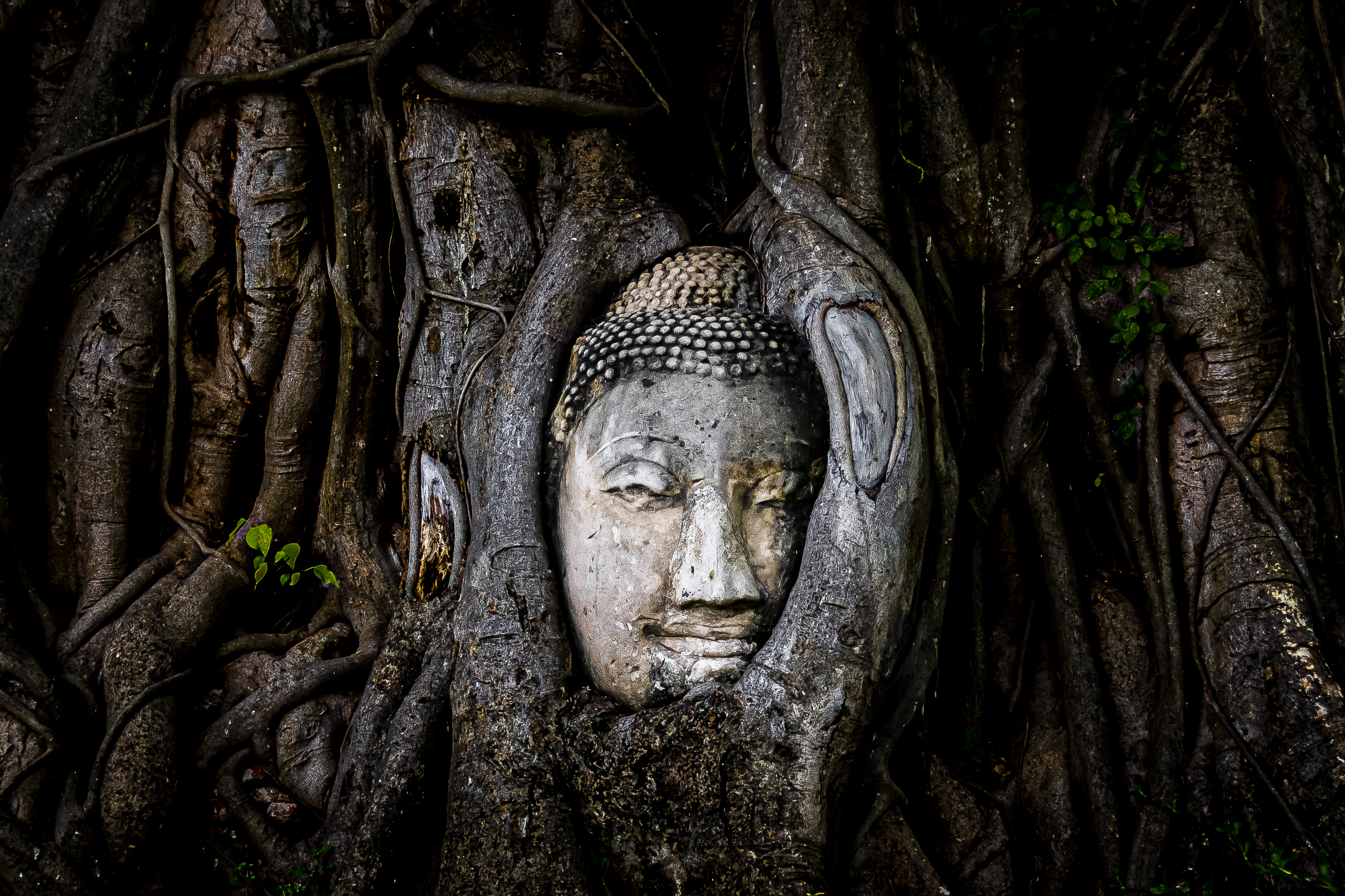
Fig tree Buddha head at Wat Mahathat (Photo: Paul Stafford for TravelMag)
There are two versions of Ayutthaya, and they couldn’t be more opposed. One is hardly distinguishable from some of the more suburban stretches of Bangkok, the Thai capital two hours by train to the south. Busy roads clamour with traffic; the shrill wails of barge whistles sound out as cargo is pulled along the Chao Phraya river, or one of the many other waterways that circumvent and enclose the main city; and swarms of wires slalom from one overloaded pylon to the next, while daily life somehow finds a way through the sultry heat and smog.
It was this Ayutthaya to which I was introduced outside the city’s train station late one evening. It was this city that kept me awake most of my first night, tossing and turning in sweat-drenched sheets, or startled awake whenever I was fortunate enough to drift off. It was these roads that seemed certain to pose major challenges to me, as I tried in vain to find what I’d been assured was a safe cycle route around the old city the next day. But then, ‘safe’ is a relative term.
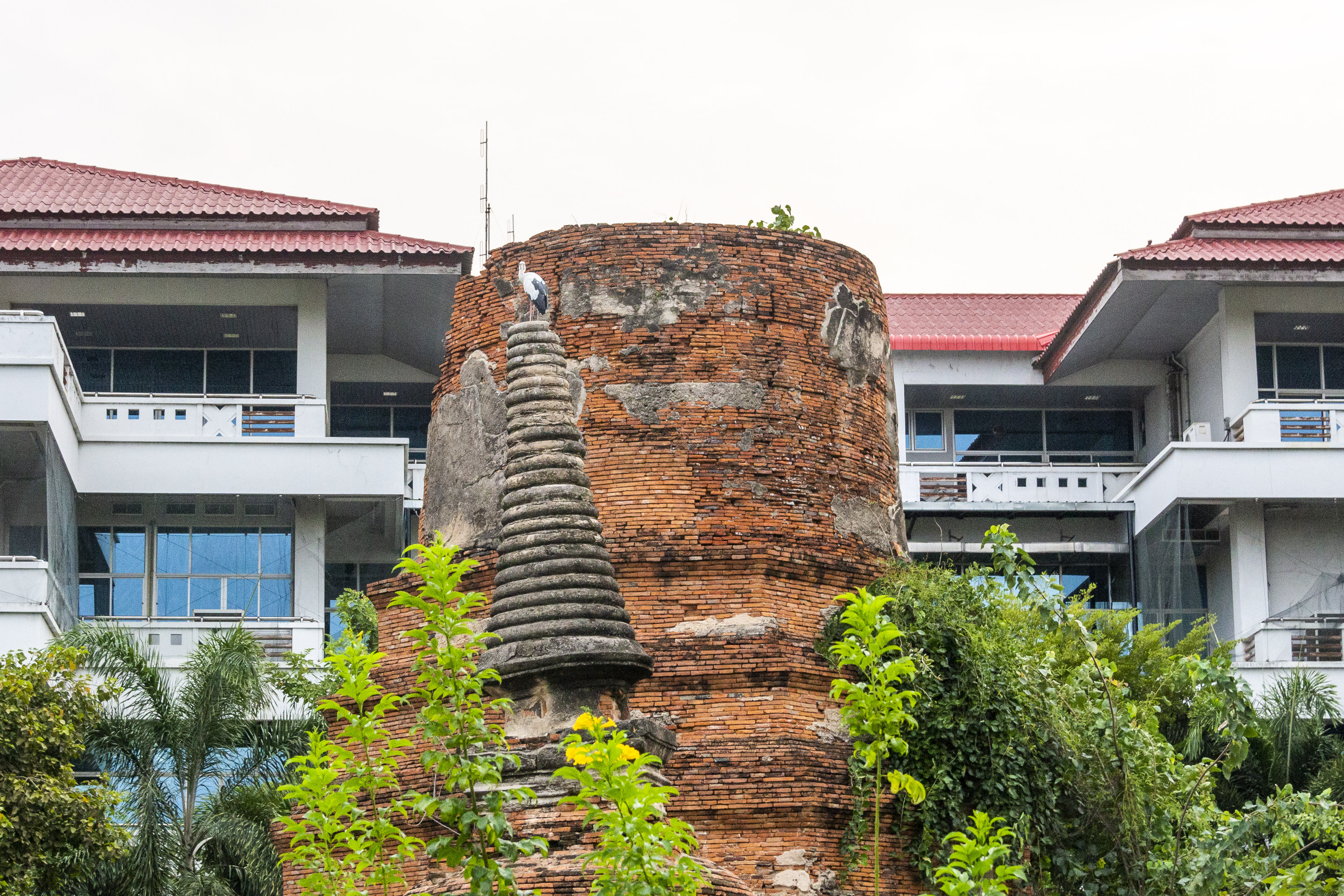
Hospital fronted by a stork-topped chedi (Photo: Paul Stafford for TravelMag)
As I pedalled along, dodging tuk-tuks packed with tourists, whose very existence seemed proof that it was possible to explore the city without sweating profusely, I caught a glimpse of the other Ayutthaya. Well more accurately, it was an Asian openbill stork that first caught my attention, with its thick beak seeming too cumbersome for its dusty frame. The stork was perched atop a weather-beaten structure that formed a shape somewhat like an upturned ice cream cone, with a much thicker, derelict column behind it, built of red bricks. This was not the chaotic, modern Ayutthaya; it was a glimpse into the past, of the Ayutthaya Kingdom’s (a Siamese empire) former capital city.
The positioning seemed unusual, on a small patch of grass, surrounded by various wards of a modern hospital. It was as if the historic structures were important enough to preserve, but not important enough to award their own enclosure, or to simply site the hospital elsewhere. And yet, seeing these two distinct versions of the city side by side felt like comparing two photographs taken centuries apart.
City within a city
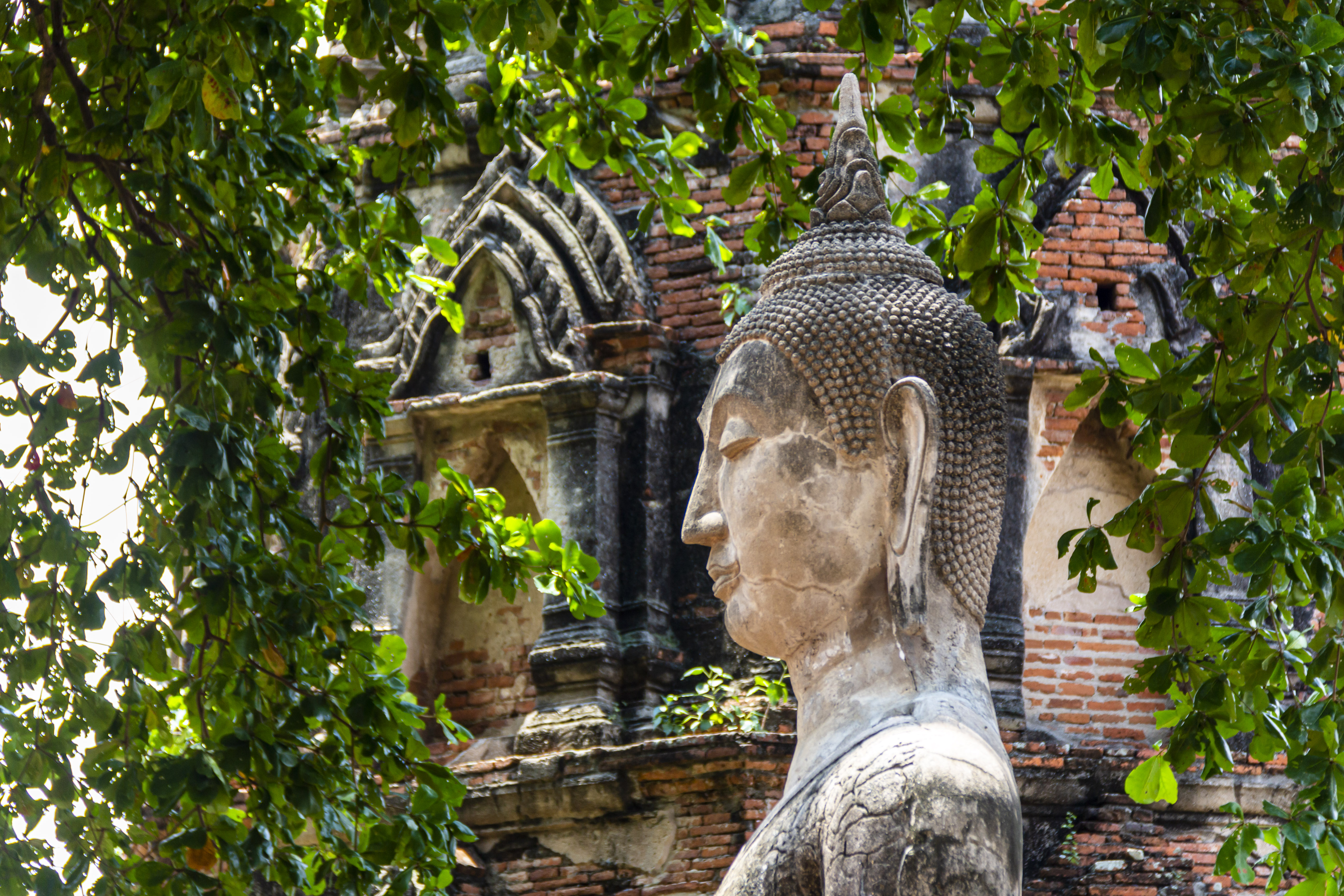
Buddha statue at Wat Mahathat (Photo: Paul Stafford for TravelMag)
Continuing to cycle north, I quickly became aware that I’d merely seen the outliers of a far vaster set of ruins. Behind the racket of one-storey stores lining the road selling fruit, curtains or cell phones, there were expanses of greenery, within which lay more structures of red brick. Each was in a state of disrepair, and more often than not, little more than a reconstructed set of foundations remained.
Then I saw the first prang (tower). Denoting what once would have been a temple, the multi-tiered tower tapered as it reached a curved pinnacle. Although little of the exterior design remained, it was clear to see, from the two remaining carved figures in its side, that it would have been ornately decorated at one point. A roofless bot (prayer room) stood beside it, containing a seated Buddha but no worshippers. In fact, there were no visitors of any kind. Neither gate nor security fence restricted access. It just blended into the rest of the city as though it were as common as a market.
The reason this ruin, as with the hospital one, lacked fanfare soon became clear: by old Ayutthayan standards, it was hardly remarkable. Beyond the modern streets lay pockets of the old city, preserved in order to offer a suggestion of their former selves. And their scale dwarfed the people who milled around them, even making the brightly-clad elephants seem Lilliputian.
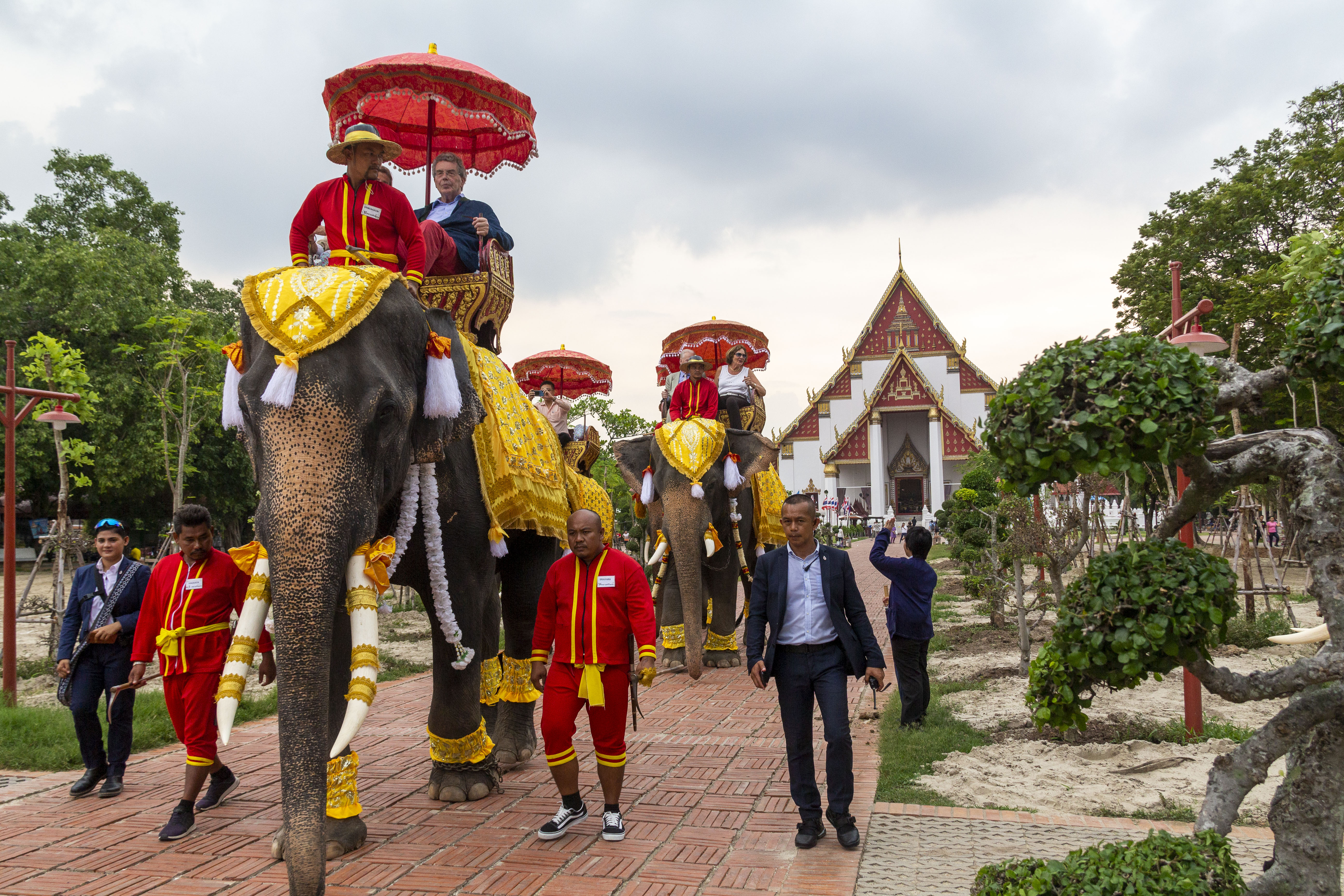
Tourists ride on elephants in front of Viharn Phra Mongkol Bopit (Photo: Paul Stafford for TravelMag)
During the Ayutthaya Kingdom’s peak in the 15th and 16th centuries, the city was one of the world’s most vibrant and wealthy. Emissaries were sent from as far away as France and Japan to establish trade links, and Buddhism flourished under the eaves of some of Thailand’s finest temples, like Wat Phra Si Sanphet, which served as the royal monastery until 1448; its three giant chedis (stupas) resembling the stork-topped one I’d first seen, but on a much grander scale.
By 1767, the city and its temples were in ruins and the rulers of Siam were banished, forced to flee. The reason: a series of fateful wars with Burma. Bringing the Ayutthayan Kingdom to its knees produced two main results: firstly, Bangkok was founded by the Ayutthayans further south along the Chao Phraya as their new capital; and secondly Ayutthaya city fell into decline after widespread destruction and looting. Temples were dismantled and a 16-metre (52-foot) Buddha statue at Wat Phra Si Sanphet was melted down to retrieve the 170kg of gold that covered it (some reports suggest it was as much as 340kg).
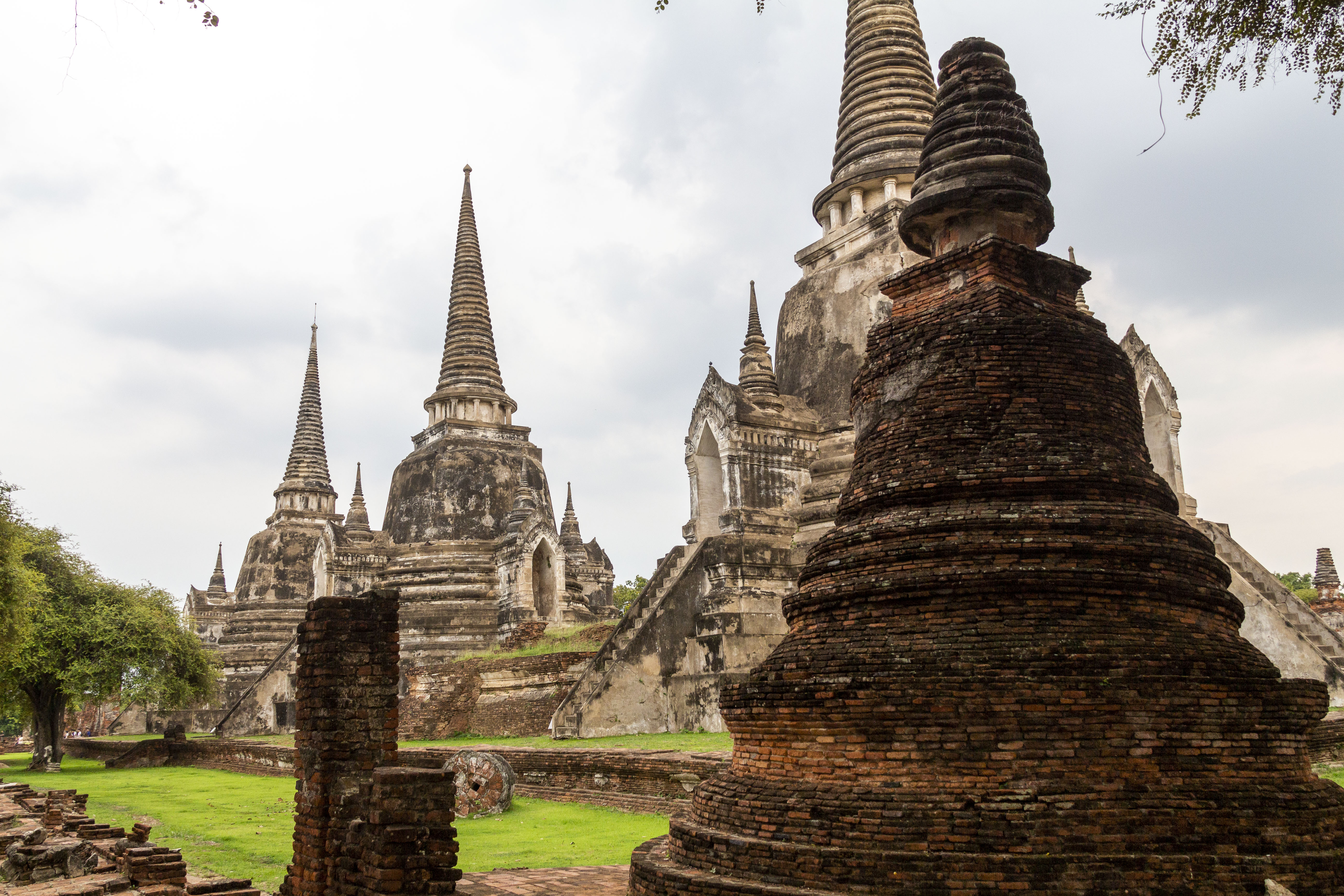
The giant chedis of Wat Phra Si Sanphet (Photo: Paul Stafford for TravelMag)
Headless relics
As I continued deeper into the spiritual heart of the old city, each set of ruins seemed larger and more impressive than the last. Some even bore the aspect of war, although that was more likely the degradation of time, given that many of the present-day structures were only rebuilt or restored early in the 20th century.
It started to dawn on me that this was once a huge city, perhaps unrivalled by any other in Thailand before the modern age. With every passing moment, the trappings of the technology age diminished. Elephants lumbered by in place of vehicles, and a monk in bright orange robes sat in the shade of a jujube tree giving a talk to a crowd of devotees.
At Wat Mahathat, the cluster of ruins was protected by a low perimeter wall. This basic layer of protection owed to the fact that a handful of the finest temples at Ayutthaya enjoy UNESCO World Heritage Site status, albeit amid reports from within the revered organization that suggest ongoing poor local management and no clear plan of conservation are hurting the ancient city.
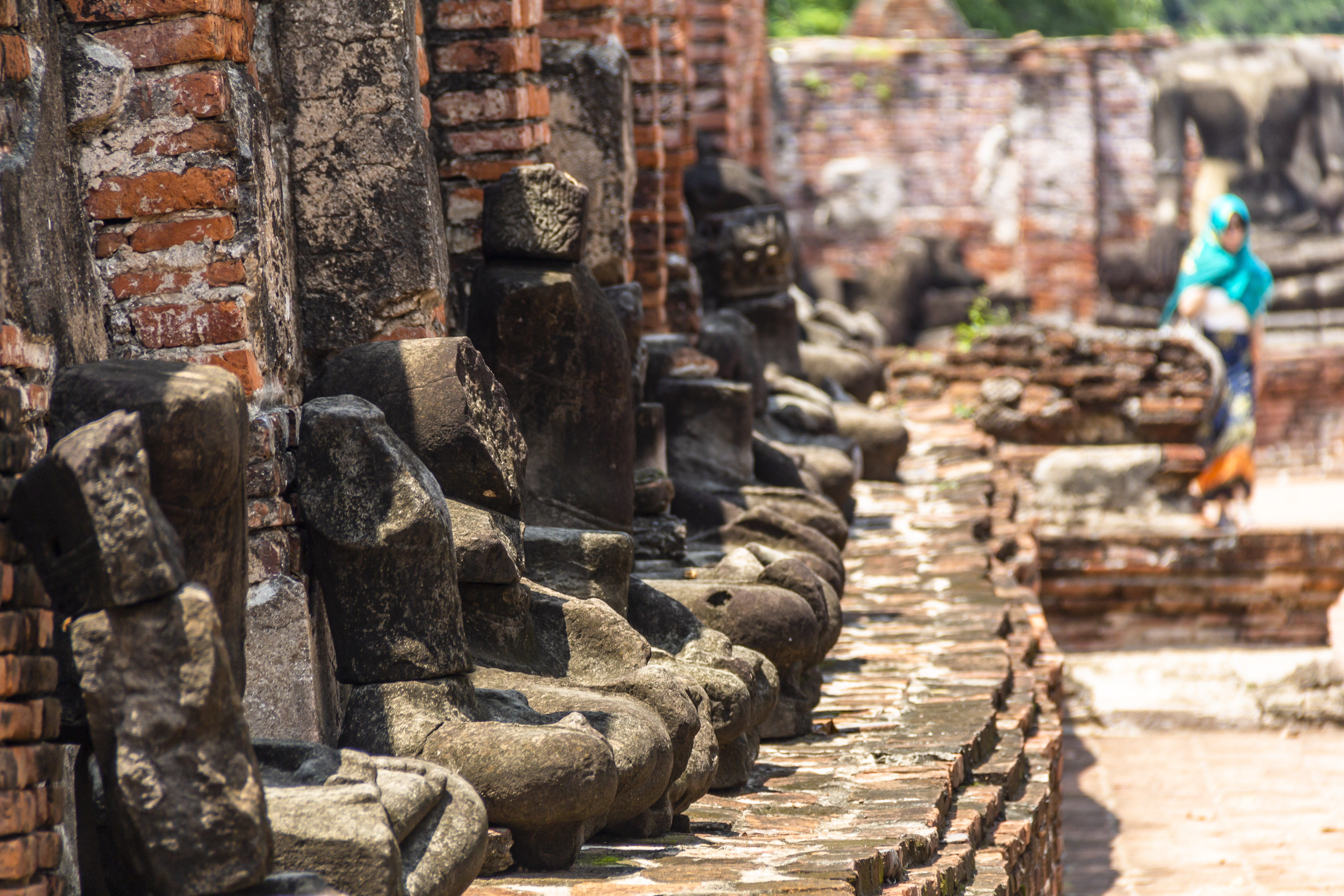
Headless statues at Wat Mahathat (Photo: Paul Stafford for TravelMag)
After buying a ticket and entering, UNESCO’s concerns were soon evident. Even here, as with the unprotected ruins, the brick walls were succumbing to time. In places they had been hastily patched up with cement, rather than using original binding agents. Yet although there was something sad about the destruction of the much-looted site, part of the decay was rather endearing. The main prang was fronted by a large, serene statue of a seated Buddha, flanked by two rows of seated worshipper statues, all of which were headless.
A missing Buddha head lay some metres away, caught in a protracted process of being devoured by the roots of a fig tree. The serenity on the Buddha’s face pierced through its ensnaring roots, as though nothing about decay was problematic. As though it were almost appreciated. Why fight what can’t be stopped?
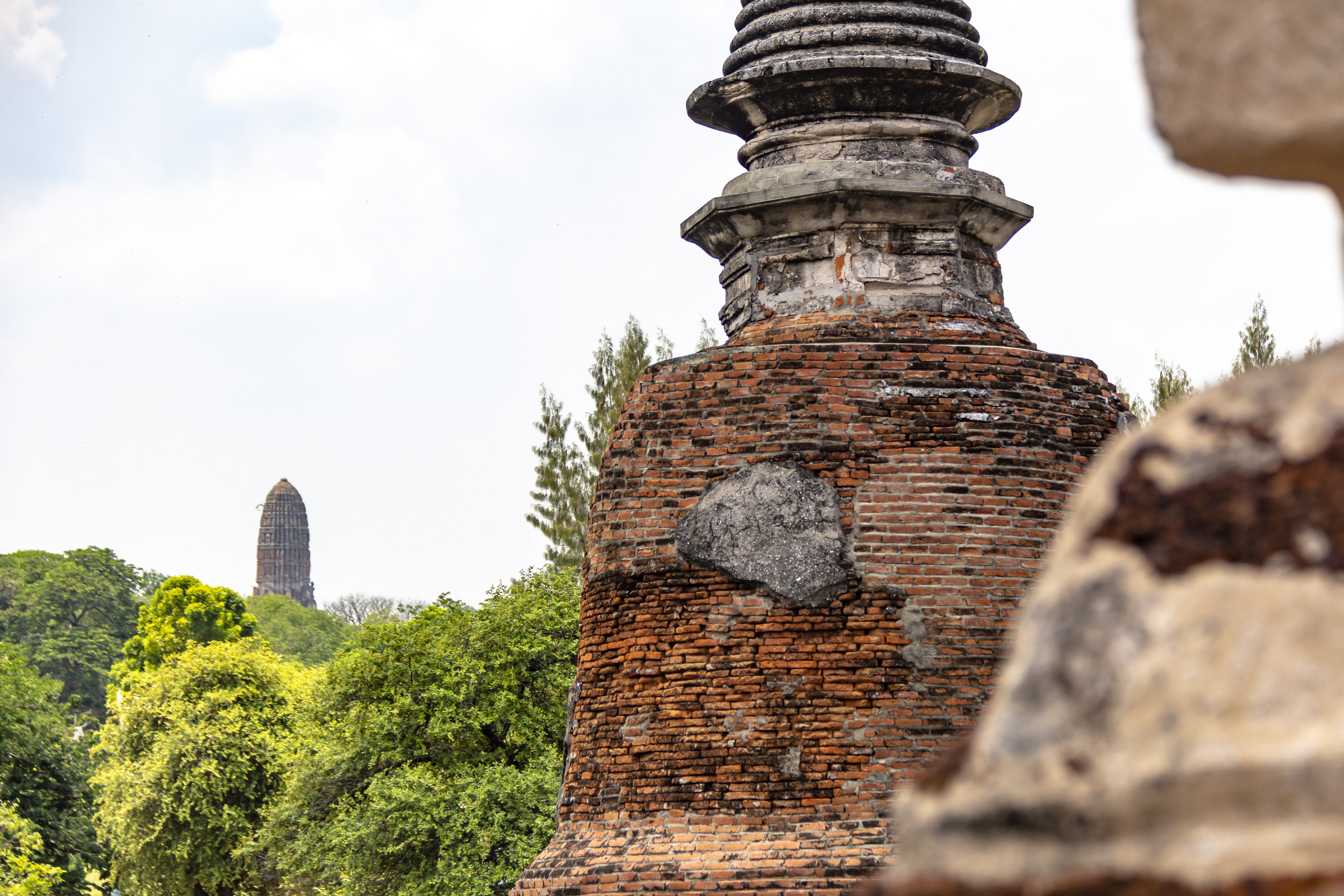
Prangs in the distance, chedis in the foreground (Photo: Paul Stafford for TravelMag)
Beacons of a looted past
From each temple, the distant prangs of other temples, poking above the treetops, could be seen, like beacons for the next destination. I cycled on through the relentless heat from one temple to the next, following their course. Wat Ratchaburana’s stunning central prang was one of Ayutthaya’s finest, and a great example of how these religious beacons would have looked in its heyday, with delicate carved stucco figures along the sides and surrounded by a smattering of beefy chedis that looked a little like bells atop octagonal platforms.
I ascended a steep staircase that flowed from the sides up into the main central chamber. The whisper of original frescoes within were now covered by bats, and a wooden grille covered the crypt, which has produced many rare Buddhist artefacts, but also lured thieves on many occasions, meaning much of what was interred now floats around the black market.
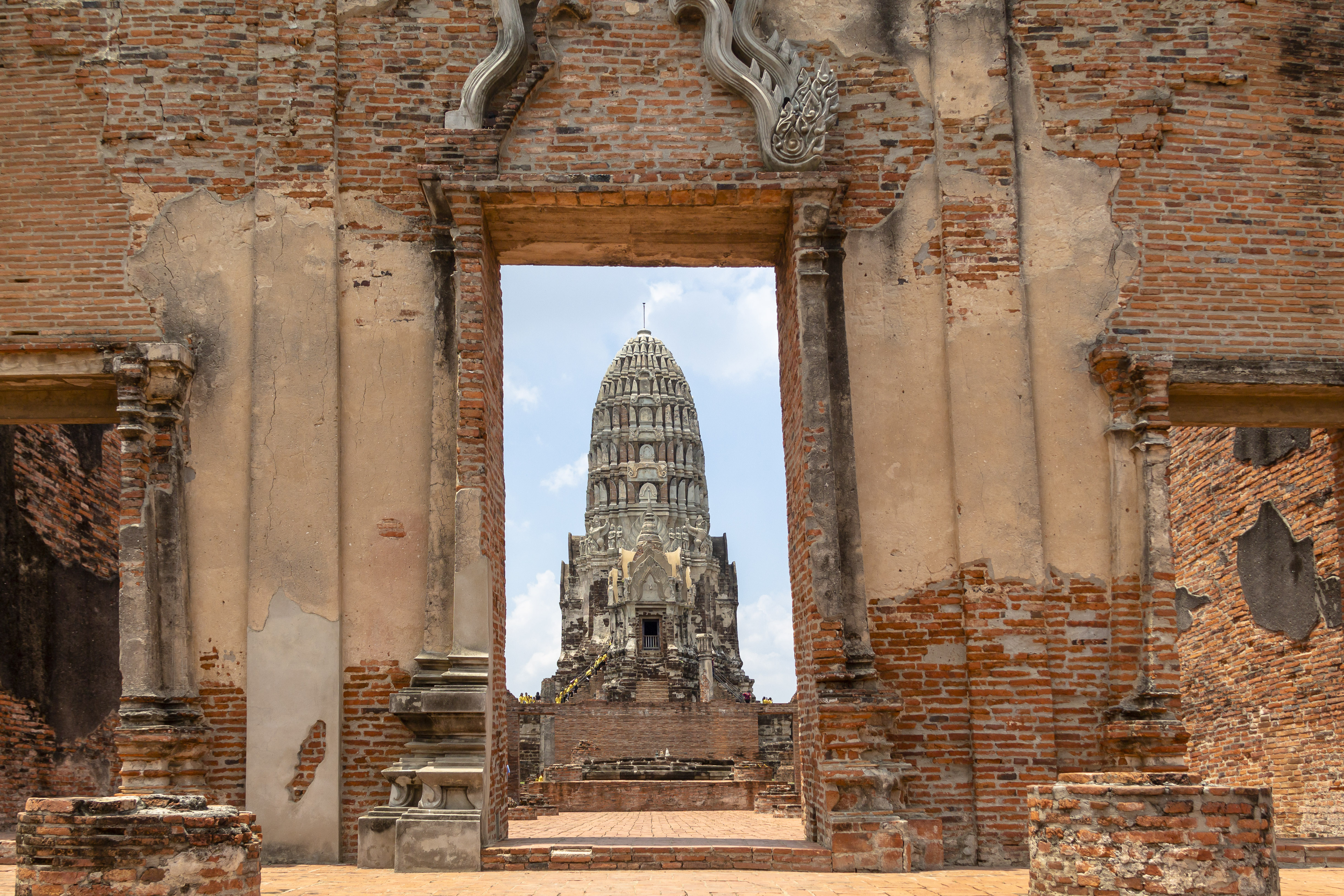
The impressive prang of Wat Ratchburana (Photo: Paul Stafford for TravelMag)
As the new city sprang up around the old, Ayutthaya’s importance has led to new wealth and opportunity, so much so that the ruins of Wat Phra Si Sanphet have a newer neighbour, the temple hall of Viharn Phra Mongkol Bopit, with its elegantly painted white and red eaves, appointed with gold flourishes. Amid the temples of yore are an increasing number of modern temples, presenting the two faces of the city.
Buddha’s pose
Daylight was starting to fade, so I continued on towards Wat Lokayasutharam. The locale changed from historical UNESCO site to residential neighbourhood as I left the main cluster of temples behind. The new city pressed in again.
The temple at Lokayasutharam was almost entirely destroyed by the Burmese and hasn’t been reconstructed. All that remained was a tilted prang, in which trees had taken root, protruding above a red-brick foundation, and a 37-metre-long, eight-metre-high reclining Buddha. A patina of weathered paint and mildew gave the impressive figure a camouflaged look.
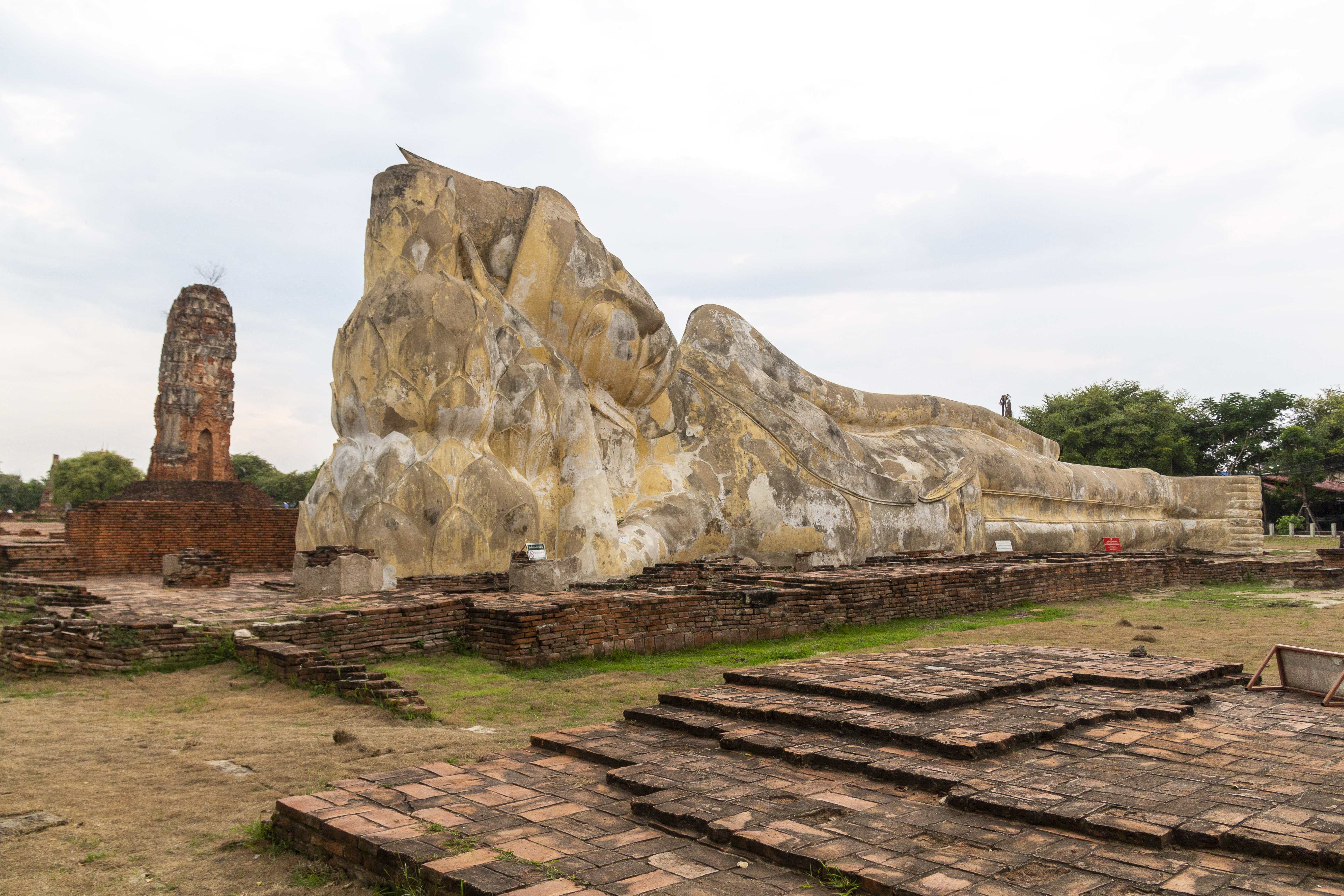
Reclining Buddha and the leaning prang at Wat Lokayasutharam (Photo: Paul Stafford for TravelMag)
Like the Buddha head in the fig tree, everything about the expression exuded peace and calm. And an acceptance of the state of things. But the juxtaposition of the reclining Buddha and the destroyed temple’s remnants, although stark, also conferred upon the Buddha an air of invincibility.
I, on the other hand, felt anything but invincible. The sun, cycling and creeping dehydration were taking their toll. I downed a bottle of water and then took my fragile self, upon my fragile bike, and pedalled with all my might through the heaving rush-hour melee, up and over an arching bridge across the Chao Phraya to the mainland; towards one final temple stop.
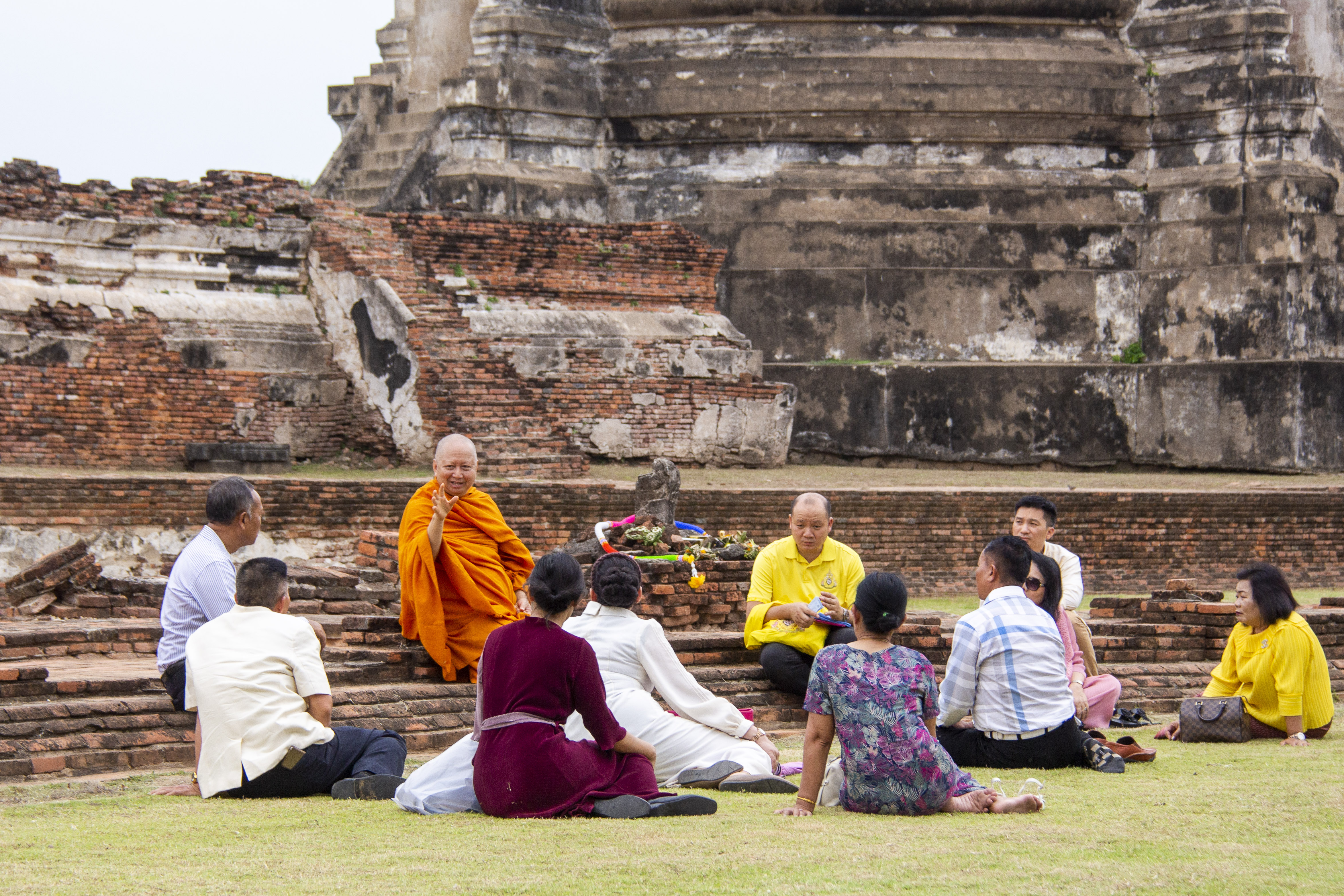
A monk and his devotees at Wat Phra Si Sanphet (Photo: Paul Stafford for TravelMag)
Across the river
Wat Chaiwatthanaram, the royal temple complex and one of the later temples to be built (1630), was one of the most complete surviving structures from the Ayutthaya Kingdom era that I saw. Its 35-metre-high central prang was flanked by chedis and cloisters that rose, on eight occasions, to spired roofs. The cloisters were lined with statues, each one seated in the lotus position and headless. Beneath each spire were further statues of what appeared to be regal figures in head-dresses vaguely reminiscent of the Ancient Egyptians.
The outer walls of the temple had a series of heavily-weathered stucco relief panels depicting scenes from the Buddha’s life. From what remained, little could be discerned, other than that they would have been elaborate and skilfully-crafted once. Suddenly feeling exhausted, I stood for some time, looking out over the dun waters of the Chao Phraya, as bats emerged from the spires to hoover up insects. Electricity sprang into a thousand tiny lightbulbs and flickered off the murky surface, the old and new facing off across the river.
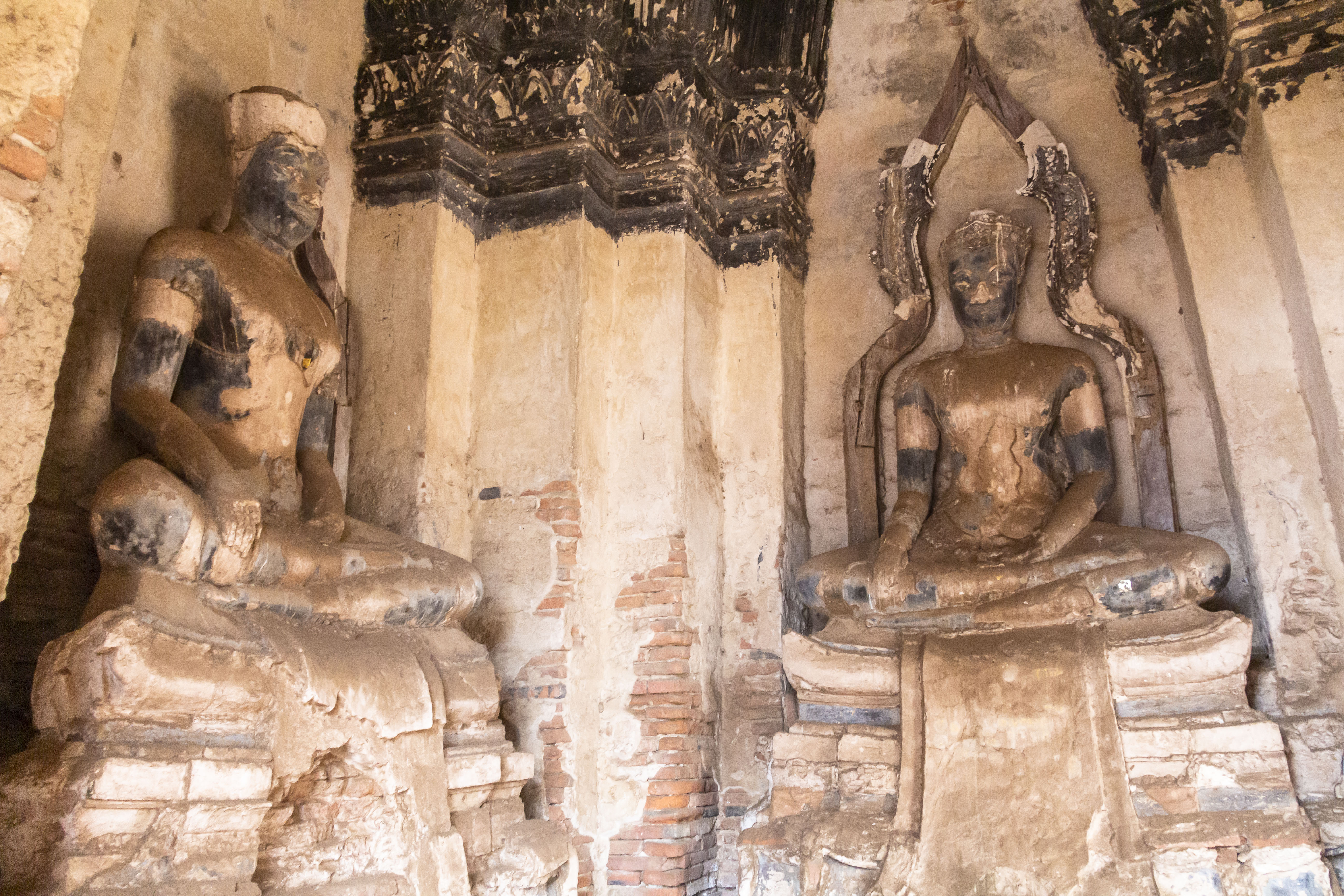
Regal-looking statues at Wat Chaiwatthanaram (Photo: Paul Stafford for TravelMag)
Cycling back over the bridge, summoning a final physical effort, the dirty haze of the modern city gave the fading sunset a sepia hue. Rush hour traffic squalled around my fragile bicycle, but I’d grown accustomed to its ebb and flow, freeing up my attention to observe the streets through which I passed. The two cities had always been there, I realised. What at first seemed like hidden pockets of ancient city, concealed behind the modernity, now seemed to define Ayutthaya, hidden but not overlooked. Inseparable, augmented and intertwined.
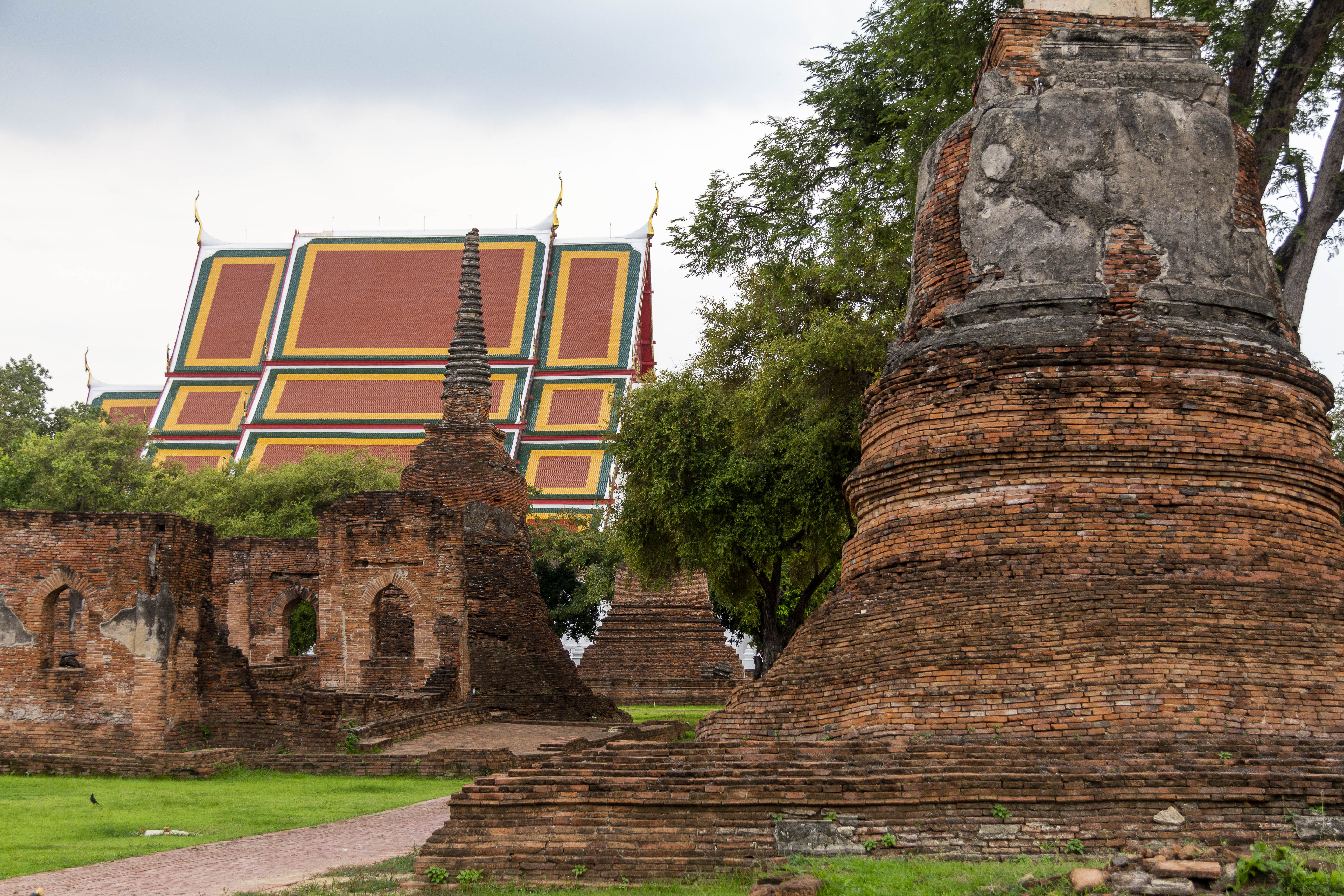
Viharn Phra Mongkol Bopit behind Wat Phra Si Sanphet ruins (Photo: Paul Stafford for TravelMag)